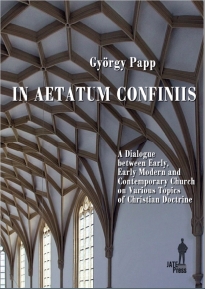In aetatum confiniis. A Dialogue between Early, Early Modern and Contemporary Church on Various Topics of Christian Doctrine
This volume contains selected papers from the broader field of History of Christian Doctrines, and more specifically from Patristics and Reformation studies, but also from the border between them. Most of them were written in the academic year 2014-2015, during my MA studies in the field of Patristics at the Theological University of the (vrijgemaakt) Reformed Churches in the Netherlands, in Kampen. The main topic of the MA programme was the Baptism in the Early Church, therefore the most of these papers presents various aspects of this question. In the following few paragraphs I will present short summary of each paper from this volume.
The first paper, which is the longest in this volume, was my MA thesis, and its topic is the reception of the teaching of the Church Fathers concerning the baptism in the 1559 edition of John Calvin’s Institutes. In this thesis, I try to unfold some of the factors that determined the way Calvin used the writings of the Church Fathers in formulating his doctrine of baptism. After presenting the patristic quotations related to the ‘theoretical’ theology of baptism, I will present the quotations and references that are related rather to the practice of baptism. Here I analyse the references regarding the doctrine of baptism coming from the Donatists, the problematic of emergency baptism and women’s right to baptize. Finally, I will present the references from Inst IV 16, dealing with infant baptism. In the last chapter of this study, I will try to summarize the conclusions of the research. I hope the reader will have a clearer image on Calvin’s use of the Church Fathers’ theological heritage on baptism in the Institutes.
The title of the second paper included in this volume is: “The Passion of the Lord Jesus Christ in Early Christian Confessions”. This paper is an expanded and somewhat more elaborated version of an earlier study in which I tried to give a general overview on the word-usage concerning the passion of Jesus Christ in the early Christian creeds. The purpose of this short paper is in part to give a comparative presentation of the sufferings of Lord Jesus Christ in the Western Creeds, and in part I also try to define the role of mentioning the name of Pontius Pilatus in them.
The third paper presents the doctrine on baptism in the Haereticarum fabularum compendium of Theodoret of Cyrus. From this presentation we learn that Theodoret presents in this work a multi-contextual image of the “all-holy” baptism. The divine origin of the sacrament determined Theodoret to offer it a special place within his theological system. This special place is expressed through the setting of the chapter concerning baptism as well: it is put between the soteriological Christology and the chapters concerning Theodoret’s eschatology, the latter being an introduction to the ethical chapters.
The purpose of the fourth paper in this volume is to analyse the concept of “imago Dei” based on the 6th answer of the Heidelberg Catechism. I chose this topic as it is one of the most controversial questions of systematic theology. If one browses through the dogmatic and ethical works written from the earliest period of Christianity to the most recent times, they will find a large variety of answers. All of these attempt to explain what the writer of Genesis meant by the expression na‘aśęh ’ ādām beṣalmenu kidemutenu. The Heidelberg Catechism deals with this topic in the 6th answer where the authors attested that God did not create the first human being godless and malicious. After stating that as a matter of fact, God created man according to his own image and likeness, the Catechism explains the term imago Dei in a twofold way: first, it seeks to define the inner content of the image and similitude of God, and secondly it expands upon the purpose of man given by God as the image of his creator within the creation. Henceforth, we shall seek to develop the meaning of this definition of imago Dei.
The last paper of this volume has a somewhat different character from the previous ones. I tried to present in it some aspects of the theological science which I considered important for the permanent renewal of doing theology in the Hungarian Reformed Church of Transylvania. I hope I made it clear through this paper that doing theology means also the shaping of a new life (both of the one doing theology and their readers), which is conceived and developing in the safety of the living-space of the New Covenant through Jesus, i.e., the Kingdom of God, which came near us. This new life, i.e., the “Kingdom-membership” implies also new understanding: a new understanding not only of the whole life but of the interpretation or definition of the essence of theological science as well.
